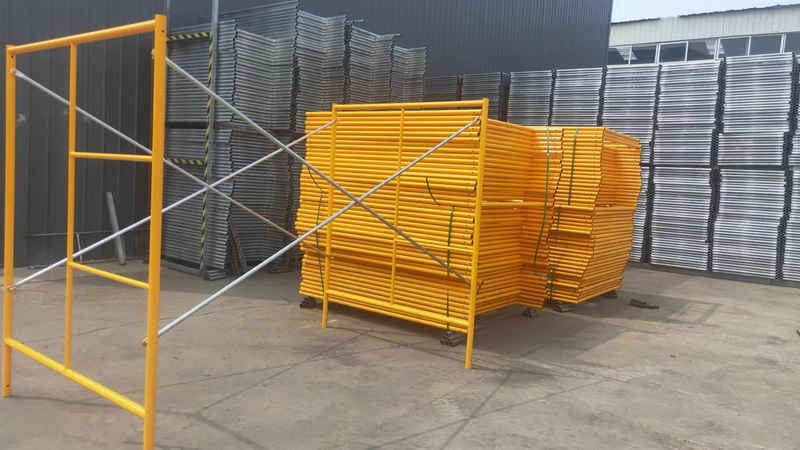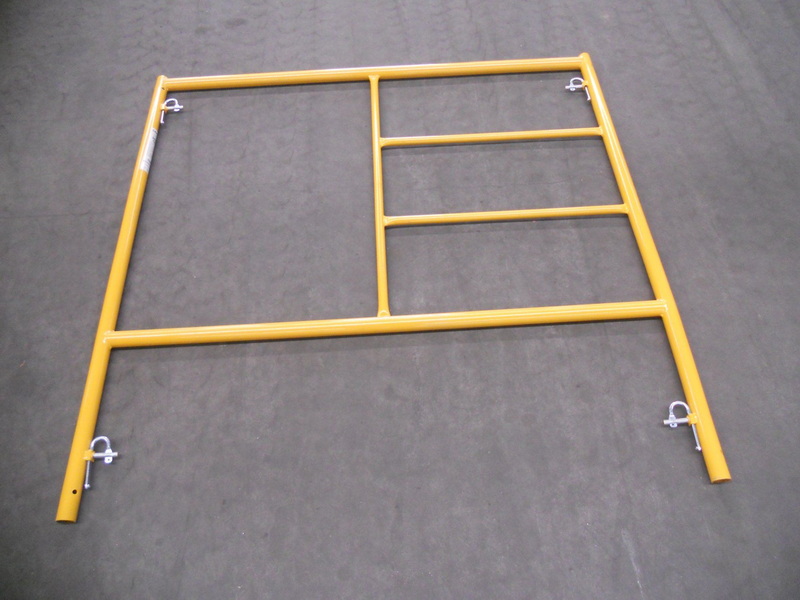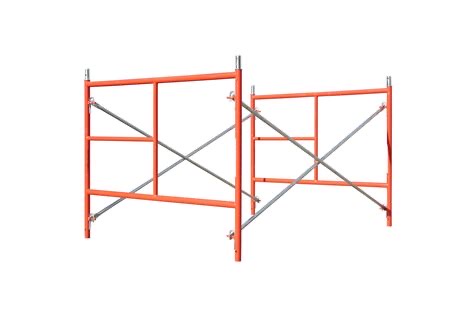Content Menu
● What Is Ladder Frame Scaffolding?
● Types of Ladder Frame Scaffolding
● Advantages of Ladder Frame Scaffolding for Residential Projects
>> 1. Versatility and Adaptability
>> 2. Quick and Easy Assembly
>> 3. Lightweight and Portable
>> 4. Built-In Access
>> 5. Cost-Effective
>> 6. Compatibility with Accessories
● Disadvantages and Limitations
>> 1. Height Restrictions
>> 2. Load Capacity
>> 3. Platform Width and Space
>> 4. Stability on Uneven Ground
>> 5. Limited Expansion
● Ladder Frame Scaffolding in Residential Applications
>> Common Use Cases
● Safety Considerations for Residential Use
>> 1. Follow Manufacturer's Instructions
>> 2. Inspect Before Each Use
>> 3. Secure Platforms and Planks
>> 4. Use on Level Ground
>> 5. Guardrails and Fall Protection
>> 6. Weight Limits
>> 7. Weather and Environmental Hazards
>> 8. Access and Egress
>> 9. Regular Maintenance
● Best Practices for Residential Projects
● Case Study: Ladder Frame Scaffolding for Home Renovation
● Comparison Table: Ladder Frame Scaffolding vs. Other Residential Access Solutions
● Maintenance Tips for Ladder Frame Scaffolding
● Innovations and Trends in Ladder Frame Scaffolding
>> 1. Lightweight Materials
>> 2. Quick-Lock Connections
>> 3. Modular Accessories
>> 4. Digital Safety Tags
● Environmental Considerations
● Tips for Choosing the Right Ladder Frame Scaffolding for Your Residential Project
● Conclusion
● FAQ
>> 1. What is ladder frame scaffolding, and how does it differ from other types?
>> 2. Is ladder frame scaffolding safe for use by homeowners?
>> 3. Can ladder frame scaffolding be used indoors and outdoors?
>> 4. What is the maximum height for ladder frame scaffolding in residential projects?
>> 5. How do I maintain ladder frame scaffolding for long-term use?
Ladder frame scaffolding, also known as A frame scaffolding, is a staple in the construction and maintenance industries. Its simplicity, versatility, and modular design make it a popular choice for professionals and DIY enthusiasts alike. But is ladder frame scaffolding truly suitable for residential projects? This comprehensive guide explores the features, benefits, limitations, safety considerations, and best practices for using ladder frame scaffolding in residential settings.

What Is Ladder Frame Scaffolding?
Ladder frame scaffolding is a modular system composed of vertical frames resembling a ladder, cross braces, and platforms. The frames are typically constructed from steel or aluminum, providing strength and durability while remaining relatively lightweight. The “ladder” design allows for easy climbing and access to different levels of the scaffold.
Key Components:
- Ladder Frames: Vertical sections with built-in rungs for climbing.
- Cross Braces: Diagonal supports that stabilize the structure.
- Platforms/Planks: Horizontal surfaces for standing and working.
- Base Plates/Jacks: Foundation elements for stability and height adjustment.
- Guardrails and Toe Boards: Safety features to prevent falls and dropped tools.
Types of Ladder Frame Scaffolding
Ladder frame scaffolding comes in various configurations to suit different applications:
- Single Ladder Frame: One side with rungs for climbing.
- Double Ladder Frame: Both sides have rungs, allowing access from either direction.
- Walk-Through Ladder Frame: One side is open for walking through, the other has ladder rungs.
- Knock-Down Frame: Modular and easy to transport, fits through narrow spaces.
- Mason Frame: Integrated ladders and frames, often used for masonry work.
Advantages of Ladder Frame Scaffolding for Residential Projects
1. Versatility and Adaptability
Ladder frame scaffolding is suitable for a wide range of residential tasks, including painting, siding, window installation, roofing, and repairs. Its modular design allows it to be configured for both interior and exterior projects, and it can be easily adjusted to different heights and lengths.
2. Quick and Easy Assembly
The simple design enables rapid setup and dismantling. Most systems can be assembled by two people without specialized tools, making them ideal for homeowners and small contractors.
3. Lightweight and Portable
Aluminum or light steel construction makes ladder frame scaffolding easy to move and transport. Knock-down frames and compact designs can fit through standard doorways, making them practical for indoor use.
4. Built-In Access
The integrated ladder rungs allow workers to climb safely between levels without needing a separate ladder. This reduces setup time and enhances safety when used correctly.
5. Cost-Effective
Ladder frame scaffolding is generally more affordable than complex system scaffolds. Its reusability and modularity also provide long-term value for homeowners and contractors.
6. Compatibility with Accessories
Most ladder frame systems are compatible with add-ons like caster wheels (for mobility), guardrails, outriggers, and adjustable jacks, further increasing their utility for residential work.

Disadvantages and Limitations
1. Height Restrictions
Ladder frame scaffolding is best suited for low- to mid-rise residential projects. For very tall structures or multi-story buildings, system scaffolding or suspended scaffolding may be required for safety and stability.
2. Load Capacity
While suitable for most residential tasks, ladder frame scaffolding may not support the heavy loads required for large-scale masonry or industrial work. Always check the manufacturer's load ratings before use.
3. Platform Width and Space
Standard platform widths may be narrower than those of system scaffolds, limiting workspace for multiple users or large equipment. For wide facades or extensive exterior work, consider the need for additional platforms or wider frames.
4. Stability on Uneven Ground
Ladder frame scaffolding must be set up on level, stable ground. Uneven surfaces require careful adjustment with base plates or screw jacks to maintain safety.
5. Limited Expansion
For projects that require wrapping around corners or covering irregular shapes, ladder frame scaffolding may lack the flexibility of modular system scaffolding, which can be configured in more complex layouts.
Ladder Frame Scaffolding in Residential Applications
Common Use Cases
- Painting and Decorating: Perfect for reaching high walls and ceilings.
- Siding and Cladding: Provides stable access for installing or repairing exterior finishes.
- Window and Door Installation: Offers a safe platform for precise fitting and sealing.
- Roofing and Gutter Work: Allows access to eaves, gutters, and roof edges.
- General Repairs: Suitable for a wide range of maintenance tasks, both indoors and outdoors.
Safety Considerations for Residential Use
1. Follow Manufacturer's Instructions
Always read and adhere to the manufacturer's assembly and usage guidelines. This ensures the scaffold is set up correctly, maximizing safety and performance.
2. Inspect Before Each Use
Check for damaged, missing, or worn parts, including welds, rungs, and locking mechanisms. Replace any compromised components before use.
3. Secure Platforms and Planks
Use locking mechanisms to prevent planks from slipping or shifting. Ensure platforms are properly aligned and locked in place.
4. Use on Level Ground
Set up scaffolding on a firm, level surface. Use adjustable screw jacks or base plates to compensate for minor unevenness.
5. Guardrails and Fall Protection
Install guardrails and toe boards on platforms where a fall risk exists. For work above 10 feet, use personal fall arrest systems (PFAS) or guardrails as required by OSHA and local regulations.
6. Weight Limits
Never exceed the rated load capacity. Factor in the weight of workers, tools, and materials.
7. Weather and Environmental Hazards
Avoid using scaffolding in high winds, heavy rain, or icy conditions. Be cautious of overhead power lines and ensure the scaffold is not conductive if working near electricity.
8. Access and Egress
Use the built-in ladder rungs or approved access ladders. Never climb cross braces or use makeshift access points.
9. Regular Maintenance
Clean and lubricate moving parts, check for rust or corrosion, and store scaffolding in a dry area when not in use.
Best Practices for Residential Projects
- Plan Your Setup: Measure the work area and choose scaffolding frames and platforms that fit your needs.
- Use Outriggers for Tall Towers: For scaffolding towers taller than three times their base width, use outriggers or tie the scaffold to a solid structure for stability.
- Tag for Safety: Use scaffold tags to indicate inspection status and safety compliance.
- Train All Users: Ensure everyone using the scaffold is trained in safe assembly, use, and emergency procedures.
- Keep Area Clear: Remove debris and obstacles from the work area to prevent tripping hazards.
Case Study: Ladder Frame Scaffolding for Home Renovation
A homeowner needed to repaint the exterior of a two-story house and replace several windows. After considering ladders and mobile towers, the contractor recommended ladder frame scaffolding for several reasons:
- Height and Reach: The two-story height was well within the safe range for ladder frame scaffolding.
- Stability: The scaffold provided a stable platform for both painting and window installation.
- Efficiency: Workers could move freely along the platform, reducing the need to reposition ladders.
- Safety: Guardrails and toe boards were installed, and all platforms were locked in place.
The project was completed on schedule, with no safety incidents, demonstrating the suitability and effectiveness of ladder frame scaffolding for residential renovations.
Comparison Table: Ladder Frame Scaffolding vs. Other Residential Access Solutions
Feature | Ladder Frame Scaffolding | Extension Ladder | Mobile Scaffold Tower | System Scaffolding |
Platform for Tools | Yes | No | Yes | Yes |
Suitable for Two+ Users | Yes | No | Yes | Yes |
Built-in Access Ladder | Yes | N/A | Sometimes | Sometimes |
Adjustable Height | Yes | Limited | Yes | Yes |
Cost | Moderate | Low | Moderate | High |
Assembly Time | Fast | None | Moderate | Slow |
Ideal for Indoors | Yes | Yes | Yes | Sometimes |
Ideal for Exteriors | Yes | Sometimes | Yes | Yes |
Maintenance Tips for Ladder Frame Scaffolding
1. Inspect before each use: Look for cracks, bent frames, or missing parts.
2. Check rubber feet and base plates: Replace worn parts to maintain stability.
3. Lubricate hinges and locking mechanisms: Ensures smooth operation.
4. Clean off debris and spills: Prevents corrosion and tripping hazards.
5. Store in a dry, covered area: Extends lifespan and prevents rust.
Innovations and Trends in Ladder Frame Scaffolding
1. Lightweight Materials
Modern ladder frame scaffolding uses high-strength aluminum alloys and advanced coatings to reduce weight without sacrificing strength. This makes transportation and assembly even easier for residential users.
2. Quick-Lock Connections
Newer systems feature tool-free, quick-lock connections that speed up assembly and enhance safety by ensuring all components are securely fastened.
3. Modular Accessories
Manufacturers now offer a range of modular accessories, such as adjustable outriggers, tool trays, and integrated safety gates, making ladder frame scaffolding even more adaptable to residential needs.
4. Digital Safety Tags
Some scaffolding systems now include RFID or QR code tags for digital inspection records, helping homeowners and contractors track maintenance and compliance.
Environmental Considerations
Using ladder frame scaffolding can be more environmentally friendly than disposable access solutions. The frames are reusable for many years, and many are made from recyclable materials. Proper maintenance and storage further extend their lifespan, reducing waste.
Tips for Choosing the Right Ladder Frame Scaffolding for Your Residential Project
1. Assess the Project Scope: Consider the height, length, and type of work. For single-story homes, a basic two-level scaffold may suffice. For two-story or split-level homes, opt for taller frames and additional platforms.
2. Check Load Ratings: Ensure the scaffolding can support the weight of workers, tools, and materials. For heavy-duty tasks, choose frames with higher load capacities.
3. Evaluate Access Needs: If frequent climbing is required, double ladder frames or walk-through frames may be more efficient.
4. Consider Storage and Transport: Knock-down or folding frames are ideal for homeowners with limited storage space.
5. Consult Local Regulations: Always follow local building codes and safety standards regarding scaffold use, especially for work above certain heights.
Conclusion
Ladder frame scaffolding is highly suitable for residential projects. Its modular design, ease of assembly, built-in access, and cost-effectiveness make it ideal for tasks ranging from painting and siding to window installation and general repairs. However, users must always prioritize safety-by following manufacturer instructions, adhering to load limits, and using proper fall protection. For most single-family homes and low-rise buildings, ladder frame scaffolding offers the perfect balance of convenience, affordability, and safety. With ongoing innovations and a strong focus on user safety, ladder frame scaffolding remains one of the best solutions for residential construction and maintenance.

FAQ
1. What is ladder frame scaffolding, and how does it differ from other types?
Ladder frame scaffolding consists of vertical frames with built-in rungs, allowing workers to climb between levels. It differs from system scaffolding, which uses a grid of vertical and horizontal tubes, and from mobile towers, which are designed for frequent repositioning.
2. Is ladder frame scaffolding safe for use by homeowners?
Yes, when assembled and used according to manufacturer guidelines, ladder frame scaffolding is safe for homeowners. Always inspect the equipment, use guardrails, and avoid exceeding weight limits.
3. Can ladder frame scaffolding be used indoors and outdoors?
Absolutely. Ladder frame scaffolding is lightweight and modular, making it suitable for both interior and exterior residential projects. Ensure the ground is level and stable for outdoor use.
4. What is the maximum height for ladder frame scaffolding in residential projects?
For most residential applications, ladder frame scaffolding can safely be stacked up to 20–30 feet. For heights above this, consult local regulations and consider tying the scaffold to the structure or using outriggers for stability.
5. How do I maintain ladder frame scaffolding for long-term use?
Regularly inspect for damage, lubricate moving parts, clean off debris, and store in a dry area. Replace any worn or missing components promptly to ensure ongoing safety and compliance.






















